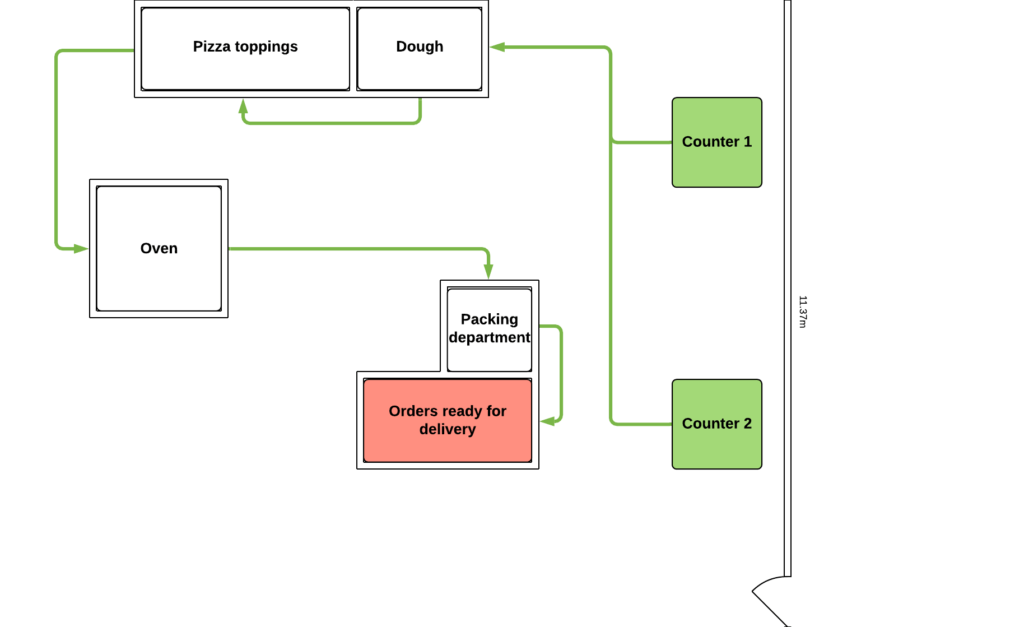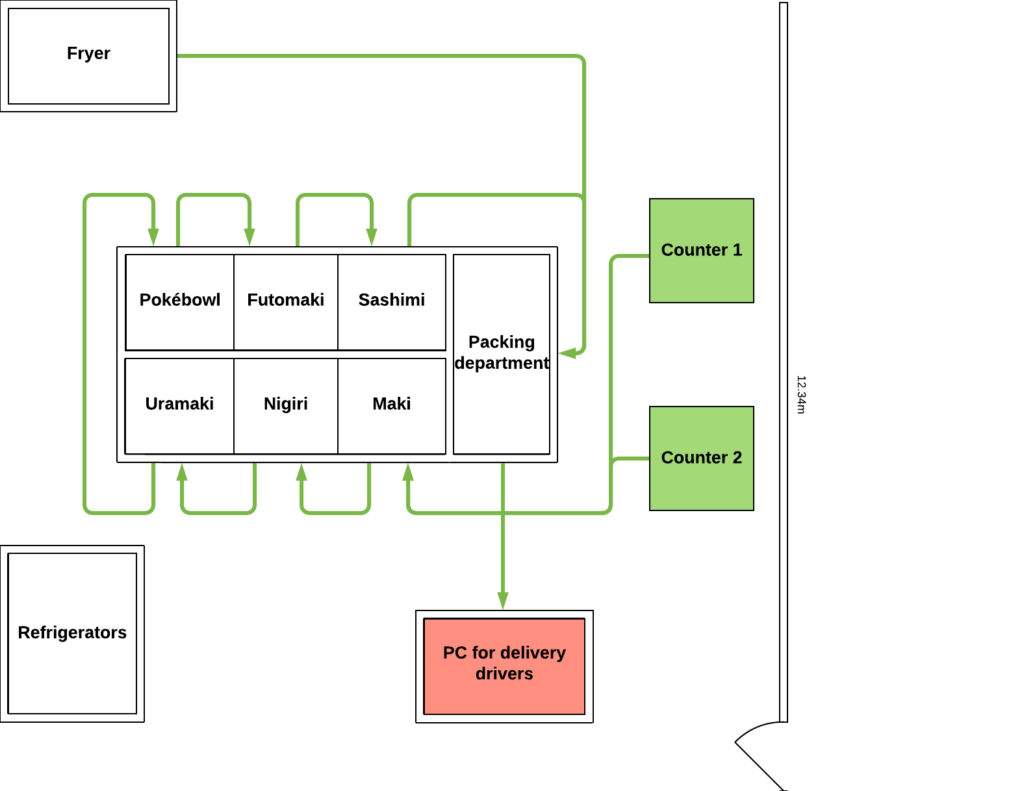Time is money and money is precious. You don’t mow the lawn with a pair of scissors, you mow it with a lawnmower right? Much more efficient! Working efficiently means doing a lot of work in a short amount of time. By working efficiently, a restaurant can, for example, save costs or optimize lead times. Over time, we have visited many restaurants and see that the hospitality industry is constantly looking for ways to work more efficiently. In this blog we share our knowledge on how delivery restaurants can set up their hospitality kitchen as efficiently as possible. Are you reading along?
The main elements in a hospitality kitchen floor plan
Just like almost every house is divided into a living room, one or more bedrooms, a kitchen and a bathroom, every hospitality kitchen consists of a number of fixed elements. Each of these elements is considered indispensable, which is why there are few kitchens that deviate from this structure. The five most essential elements of a hospitality kitchen design are now briefly explained:
1. The storage area
One or more places where kitchen utensils (pans, cutting boards, knives, etc.) and food can be conveniently stored. It is common to include space for a refrigerator, lockable cabinets and/or shelves in the layout of a hospitality kitchen. Often, these spaces are scattered throughout the kitchen.
2. The cold kitchen
Logically, this is where the cold products are processed and prepared. Refrigerated work tables come in handy in the cold kitchen given the importance of a cool temperature in this area. After all, you don’t want your salad to arrive at the same temperature as a hot pizza. 15 degrees Celsius is considered to be optimal for the cold kitchen. (Dullemen, 2020).
3. The warm kitchen
In the warm kitchen, products are baked, boiled, cooked, roasted and/or steamed. Usually there are several workstations in the warm kitchen so that, for example, meat and fish are not prepared in the same place. Most kitchen equipment can often be found in this department (oven, microwave, fryer etc.).
4. The packing department
From the warm kitchen, we move on to the packing department. The packing department is both the department for the ‘finishing touch’ (for example, putting rocket on a pizza) and the place where orders are prepared for departure and handed over to the delivery staff. Keeping the dishes at the right temperature is very important here. This can be done, for example, by placing trays and/or bowls of food, often sauces in this case, in hot water. This technique is also called ‘au bain-marie’. Another technique is the use of hot plates that work on electricity. This is widely used by delivery restaurants in particular.
5. The rinsing kitchen
This is the department where the used kitchen utensils are returned. Often, the fresh vegetables are washed here as well. When everything has been washed and dried, it can be put back in the appropriate cabinets and racks.
Kitchen layout, floor plan and routing
How can you arrange these five departments in an efficient way so that, for example, the staff has to cover as little distance as possible while lines of communication are as short as possible? By consciously thinking about this challenge when setting up your catering kitchen, you can use all your space more efficiently.
Traditional restaurants are being judged, in addition to the price-quality ratio, mainly on the ambiance of the restaurant. With delivery restaurants, on the other hand, ambiance plays a smaller role. Therefore, the delivery time has more influence on the evaluation. Thus, within the world of meal delivery, even more than with other catering establishments, it is all about speed. In addition to speed, you must also take into account the mise en place, staffing and safety.
Fast, faster, fastest!
In order to streamline the process, it is important that all products and table supplies can be moved in an efficient manner. A so-called production line comes in handy here and is often used by delivery restaurants. In essence, a production line means that the catering kitchen is set in a way that a dish is processed at each stop, before being passed on to the next stop in the production line. See also the hospitality kitchen floor plan below. The following steps in the production line of a pizzeria clearly demonstrate this: (1) preparing the dough, (2) adding toppings to the pizza, (3) baking the pizza in an oven and (4) preparing the pizza for delivery. Depending on the crowd, space has been created on the floor plan at each stop for a separate workstation. Outside of peak hours, multiple steps can possibly be performed by the same employee.
Using a production line, both cooks and ingredients travel relatively short distances. This is advantageous because walking takes time and thus comes at the expense of efficiency. In addition, walking people create chaos so that employees, for example, bump into each other and no longer dare to move ‘blind’ in the hospitality kitchen. When your staff dares to move blindly in the hospitality kitchen, they can pay less attention to their actions, which benefits their productivity.

Sample hospitality kitchen floor plan pizzeria: In the first example of a pizzeria formula, you can see that orders come in through the two counters. Then the dough is prepared and topped with the chosen toppings. The pizza is baked in the designated (stone) oven. After that it can go to the packing department where the pizza is cut into pieces and packed. When an order is placed on the rack, the deliverers know that the pizzas are ready to go.
Efficient communication between employees in the hospitality kitchen
Imagine that Chef A regularly has to consult with Chef B while Chef A works at the very front of the kitchen, and Chef B at the very back. The result is that they either have to coordinate things with each other shouting, or they have to cross a certain distance each time they interact. Yelling can distract others and leads to more chaos in the kitchen. Walking on the other hand takes time and, like yelling, also leads to chaos in the kitchen. Both situations are not conducive to efficiency and speed and should therefore be avoided as much as possible.
A hospitality kitchen layout with a kitchen island can possibly provide a solution in this case as it creates a central point in the kitchen. In addition, such a cooking island makes it easier for the chef to keep an overview. The downside is that a kitchen island takes up a lot of space. Therefore, it is primarily a valuable design for hospitality kitchens with enough space where one cook controls the entire process. However, not every delivery restaurant works this way. Below is an example of a catering kitchen floor plan with a kitchen island for a restaurant that delivers sushi.

Example catering kitchen floor plan sushi restaurant: In the second example of a sushi restaurant formula, orders also come in through two counters. Each order then passes through all departments where one type of sushi is prepared per department. When an order goes to the packing department, frying is added at the last minute (if applicable) so that it is delivered as hot as possible. At the packing department, there is one person who hands the orders off to delivery drivers and takes care of communication with them.
Staffing in the kitchen
It was briefly mentioned earlier, staffing in the kitchen. At quiet moments, tasks can be combined and not all workstations need to be occupied. At the same time, there must be the ability to scale up during peak times. This can be done by having each employee in the catering kitchen perform only one task in the production line. On the one hand, it will be at the expense of efficiency if there are more employees working in the kitchen than are needed. On the other hand, understaffing will lead to dissatisfied customers and longer lead times. The right balance needs to be found constantly. You will notice that this will eventually improve when you use data to your advantage in this challenge. By hanging up KPI screens in your kitchen you and your staff can easily keep an overview.
Another point to consider is that not every employee is the same. This should be taken into account while distributing tasks, and thus in the staffing of the hospitality kitchen. For example, it would not be practical when the chef is washing and cutting the vegetables while a kitchen assistant could also have done that. Delivery staff can also play a role in this at certain moments.
Mise en place
A good mise en place makes it easier to find the right balance in your staffing in the kitchen. Mise en place is a French term and means “put into operation” (Cocina, 2020). A mise en place aims to prevent delays in the execution of tasks. Ingredients will already be collected, processed and stored in the right places well before orders are being packed. In addition, the necessary kitchen utensils are prepared in advance. A mise en place ensures that employees can make themselves useful during quiet moments, taking the pressure off during peak hours. In other words, the quiet moments become busier and the busy moments become quieter. This allows occupancy to remain more constant throughout the day.
Restaurant owners often forget that the kitchen must be conveniently arranged not only during peak hours, but also during a mise en place. Do you want to cut and pack thirty portions of carpaccio in advance? Then there must be room to then store them in a convenient place (refrigerated). Just before a carpaccio goes out the door, all you have to do is add the Parmesan cheese, pine nuts and dressing.
Health and safety in your restaurant’s kitchen
Finally, health and safety. This also affects the hospitality kitchen design. One example is the height of your catering equipment. Make sure that your employees do not have to work with a crooked back. In addition, think of a walking route so that employees will not easily bump into each other (or against hot catering equipment) so that they dare to walk ‘blind’ through the kitchen. As far as food safety, the health of your staff and fire safety are concerned, we will keep it simple since this does not directly affect efficiency. We advise you to (at least) comply with the legislation.
CashDesk kitchen screens: more overview, less mistakes and better communication with the customer
By working with kitchen screens in the kitchen of your restaurant, you can say goodbye to paper receipts. It’s easier to edit receipts online and you get a clearer overview than if your chef had to hang them up piece by piece. If you also use the delivery app, every order is automatically and correctly updated in the live order checker. This improves communication to the customer and will prevent anxious phone calls.
Want to know more about our smart solutions for delivery restaurants? Then do not hesitate to contact us!
Thank you for reading,
CashDesk
References
- Cocina, M. (2020, 17 juni). Mise En Place, Past U Het Toe In Uw Restaurant?
- Dullemen, E. (2020, 25 juli). Hoe start je een restaurant 16: Routing & lay-out van een horecakeuken.
 CashDesk NL
CashDesk NL CashDesk BE
CashDesk BE CashDesk EN
CashDesk EN CashDesk DE
CashDesk DE


